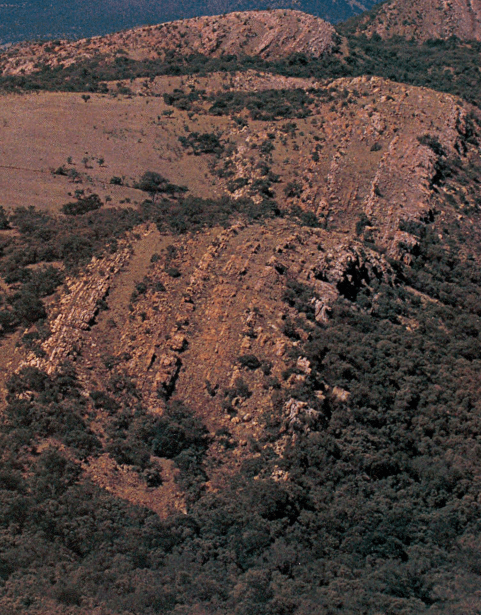 Gold prospecting seeks to find new gold deposits. Gold is typically found in placer deposits or in hard rock deposits. The type of deposit dictates the methods used to explore for them. Mineral exploration on a budget can be successful if you understand the basics of geology.
Gold prospecting seeks to find new gold deposits. Gold is typically found in placer deposits or in hard rock deposits. The type of deposit dictates the methods used to explore for them. Mineral exploration on a budget can be successful if you understand the basics of geology.
Gold Prospecting in Placer Deposits
Placer deposits are defined as an accumulation of valuable minerals formed by deposition by gravity during sedimentation processes. Gold, is a relatively heavy material which can only be suspended in streams when the flow is high. Indeed, gold is much denser than gravel and other materials often suspended in stream flow. The specific gravity (which is a measure of the mineral’s density compared to water) of gold is approximately 19, while that of gravel is only 2.7. Consequently, when the stream flow slows down, the gold falls out of suspension and forms a placer deposit.
When considering a location for placer mining, a prospector normally looks for the following:
- A stream with an operating mine or a known mother-lode nearby
- A stream where gold has been found before
- Areas in the selected stream where the flow is low, such as the inside of a bend, the bottom of the waterfall, trailing edge of sand or a gravel bar, or behind a large boulder
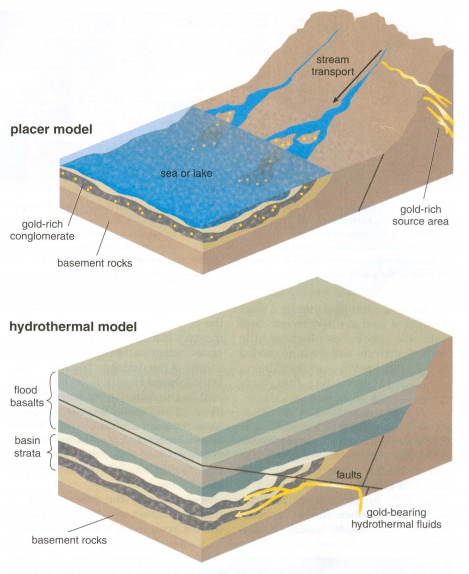
- Underneath the moss on top of the bedrock. The moss is shaken out and scrubbed to get out as much loose material as possible from underneath the bedrock.
- Inspection of any fractured quartz vein with decomposed iron. Sometimes these may have gold too. One prospector known to the authors found 100 ounces in such a vein near Likely, BC, beside a stream.
- Vertical strata in the bedrock or boulders in the stream. These can act as riffles where gold washes over them and becomes trapped in during periods of high water. During periods of low water, these can be opened up with a hammer and chisel to collect rock fragments which can be inspected for gold. In addition, highly oxidized areas in the bedrock can yield gold.
- Eskers: gold can sometimes be found at the interface of the esker and the underlying bedrock. Eskers are sand and gravel deposits from streams which flowed inside melting glaciers.
Various types of equipment are used to extract gold from the placer deposits, such as gold pans, rocker boxes, sluice gates, and dredges. Gold panning is the cheapest, but its low productivity rates limit its use to primarily recreational prospecting.
Rocker boxes and sluice gates are relatively cheap and are more productive than panning and are suitable for small scale operations. Gold dredging is more productive and is used in larger scale operations, but requires a significant capital outlay and is normally beyond the financial capability of most prospectors. Another method is hydraulic sluicing whereby a bank of overburden material is washed down to a sluice box by a high pressure hydraulic monitor. Due to its deleterious effect on the environment this is more a thing of the past now.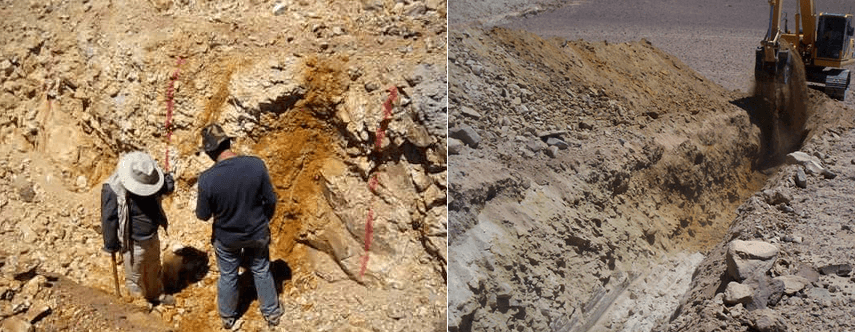
Placer gold mining tends to be a low percentage play with only modest profits. Most streams with known placer deposits in the Canadian and American West have been picked over several times leaving very little left for current prospectors. Though the price of gold has risen dramatically since the 1960’s from $35/oz to $1200/oz (2015), it is still normally not highly lucrative. The cost of related equipment and services have increased many fold as well, thus impacting the profit potential.
Gold prospecting in Hard Rock deposits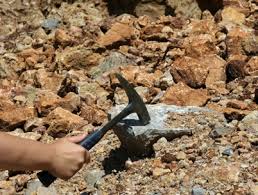
The method of gold prospecting varies with the financial resources of the prospector. The methods typically employed are:
- Examination and surface sampling of outcrops in the property using a hand lense and rock hammer
- trenching with a backhoe or excavator in areas where the overburden is shallow
- aerial magnetometer surveys
- drilling (either diamond drilling or dual rotary/reverse circulation)
Surface sampling aided with a rock hammer and hand lense is the cheapest of all methods and is within the financial means of all prospectors. Typically the prospector checks the rock outcrops on the property for indicator minerals such as magnetite, sulphides such as pyrite and chalcopyrite and exposed quartz veins. Those in-field samples are often analyzed immediately using a portable XRF which give a good approximation before going to an expensive assay lab.
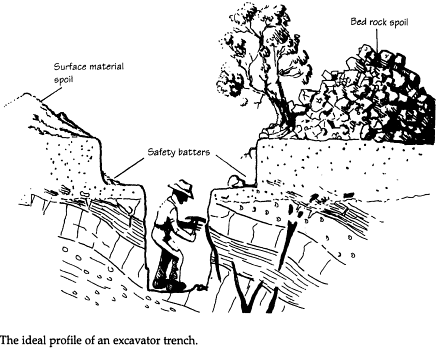 Trenching with a backhoe or excavator allows the prospector to investigate the rock in the subsurface to a depth limited by the reach of the backhoe. On a property with very few outcrops, trenching is a practically a necessity. This is the case at the Sego Resources copper gold property just above the town of Princeton, in southern BC, just north of the Copper Mountain mine. The samples taken from the rock in the subsurface are inspected and analysed for gold, presence of quartz veins and the indicator minerals mentioned above. Trenching, is of course more expensive than surface sampling and may be beyond the means of some prospectors.
Trenching with a backhoe or excavator allows the prospector to investigate the rock in the subsurface to a depth limited by the reach of the backhoe. On a property with very few outcrops, trenching is a practically a necessity. This is the case at the Sego Resources copper gold property just above the town of Princeton, in southern BC, just north of the Copper Mountain mine. The samples taken from the rock in the subsurface are inspected and analysed for gold, presence of quartz veins and the indicator minerals mentioned above. Trenching, is of course more expensive than surface sampling and may be beyond the means of some prospectors.
Aerial magnetometer surveys are conducted with the use of a magnetic survey instrument slung from beneath a helicopter. From the air, the survey instrument is able to detect magnetite, which often occurs with sulphides in the subsurface. This information is highly valuable because the occurrence of sulphides, is highly correlated to the presence of gold and copper. This allows the surface sampling program to target areas that have a higher probability of finding indicator minerals and gold. IP or induced polarization surveys can also detect sulfide zones either as high conductors or low resistivity zones.
There are many different types of deposits containing gold, – some of them more defined than others. Three of the more common types are discussed below:
- Structurally controlled quartz veining is one of the most common types of deposits in North America that contain gold. This includes Mexico and Central America. These deposits are formed when hydrothermal fluids containing silica and gold cool off in cracks and faults in the rock mass. These fluids solidify at a relatively low temperature for gold when compared to their source magma and some other hydrothermal fluids and thus occur closer to the surface, away from the heat source.
- Gold also commonly occurs in conglomerate deposits. Conglomerate deposits
are historic placer deposits in gravels that have been petrified. A major example is the Witwatersrand deposit in South Africa. 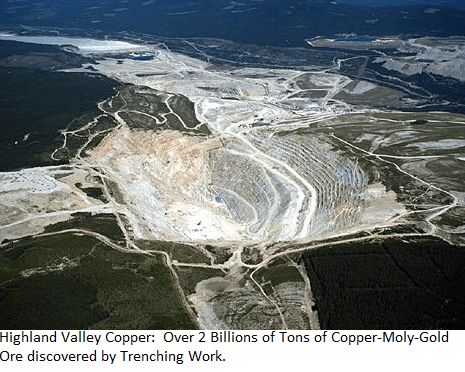 Gold along with copper commonly occurs in porphyry deposits. Porphyry is generally defined as an igneous rock consisting of large-grained crystals such as feldspar or quartz dispersed in a fine-grained groundmass. Hydrothermal fluids containing sulphides associated with gold and copper are commonly deposited in cracks and faults in the porphyry. These hydrothermal fluids are usually at a different temperature than the temperature of formation of the porphyry minerals. For example, the plagioclase feldspars were formed at very high temperatures and in contact with the cooler hydrothermal fluids, form argillic or clay alteration to such minerals as kaolin. The type of alteration is a key tool for the prospector to determine the probable occurrence of gold and copper. For example, extensive argillic alteration can indicate a major hydrothermal plumbing system, often connected to sulfide mineralization. This was a key factor in the discovery of the Lornex orebody by a prospector, Egil Lorntzen, in the 1960’s in the Highland Valley of southern BC which is primarily a copper and moly deposit but with minor gold and silver in the smelter returns.
Gold along with copper commonly occurs in porphyry deposits. Porphyry is generally defined as an igneous rock consisting of large-grained crystals such as feldspar or quartz dispersed in a fine-grained groundmass. Hydrothermal fluids containing sulphides associated with gold and copper are commonly deposited in cracks and faults in the porphyry. These hydrothermal fluids are usually at a different temperature than the temperature of formation of the porphyry minerals. For example, the plagioclase feldspars were formed at very high temperatures and in contact with the cooler hydrothermal fluids, form argillic or clay alteration to such minerals as kaolin. The type of alteration is a key tool for the prospector to determine the probable occurrence of gold and copper. For example, extensive argillic alteration can indicate a major hydrothermal plumbing system, often connected to sulfide mineralization. This was a key factor in the discovery of the Lornex orebody by a prospector, Egil Lorntzen, in the 1960’s in the Highland Valley of southern BC which is primarily a copper and moly deposit but with minor gold and silver in the smelter returns.
Mining for hard rock deposits containing gold is a much more expensive proposition than placer mining. Typically the prospector will either sell his interest to, or form a joint venture with an intermediate or senior mining company who have the financial capability of developing the resource. Gold deposits can be extracted either by open pits or underground mining. Whether it is open pit or underground depends on the grade of the deposit and also its geometry and size. A high grade deposit like say 60 grams/tonne and in steeply dipping veins will probably be mined underground, whereas a porphyry type gold deposit, say with 5 grams per tonne which is large and low grade is more amenable to open pit mining.
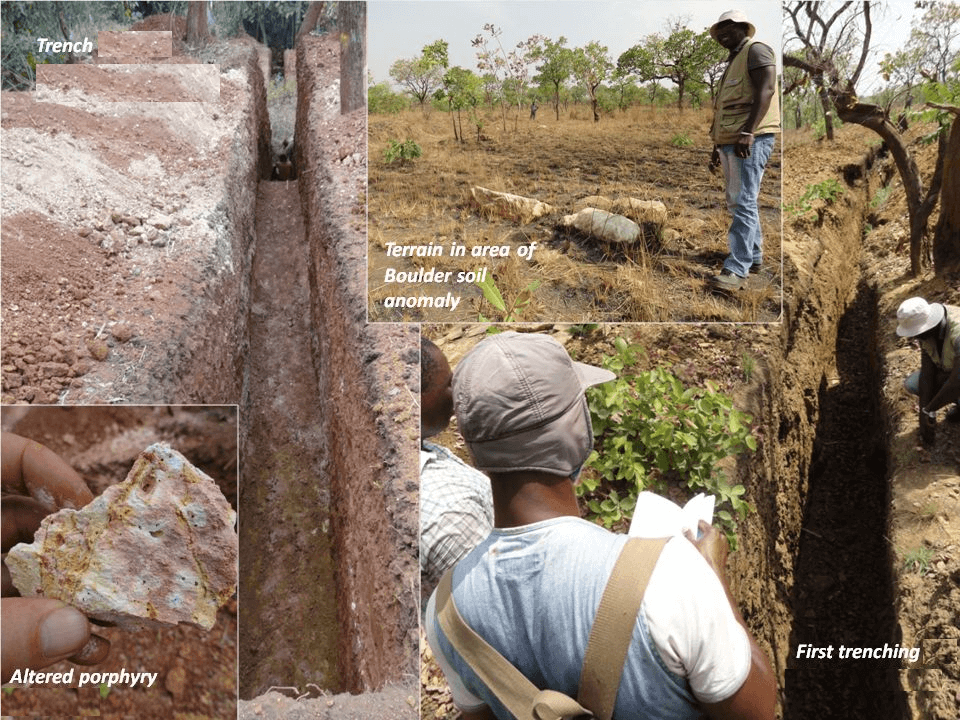
https://www.americanscientist.org/issues/pub/the-origin-of-gold-in-south-africa/
